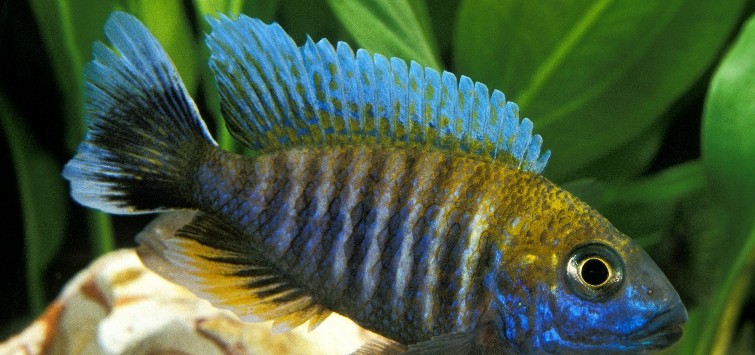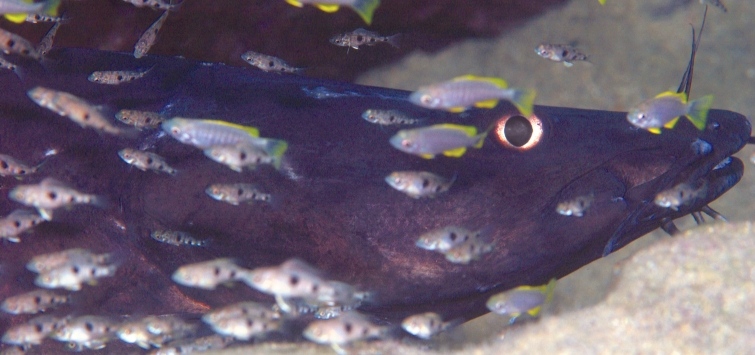Pretty Peacock Cichlids from Lake Malawi
Author: Brian M. Scott
There are few freshwater fishes that rival the spectacular coloration of the Malawi peacock cichlids. These interesting and colorful cichlids, members of the genus Aulonocara, have long been favorites among freshwater aquarists.
Aulonocara is made up of at least 20 species, but this number can vary depending on the source. There are also quite a few captive-produced color varieties and hybrids, which can sometimes be confused as naturally occurring species. Furthermore, within individual species there are often line-bred strains that have been produced for certain traits or qualities, like enhanced blue or yellow coloration, or other features like albinism or long fins.
Peacock cichlids are among the dozens of endemic genera in Lake Malawi, where they primarily inhabit rocky reefs and shorelines, though some species can be found among sandy flats with scattered boulders. By volume, Lake Malawi—one of the major lakes within the East African Rift System—is the fourth largest freshwater lake in the world.
It’s estimated that the lake holds more than 700 species of cichlids, most of which are naturally found nowhere else. The clear, warm tropical waters of Lake Malawi are alkaline in nature and generally have a pH ranging between 7.2 and 8.5 depending on location and water depth.
Setting Up a Peacock Cichlid Tank

As with most types of fish maintained in aquariums, the larger the tank the better. The key reasons for this are stability and space. Larger volumes of water are more stable, not only in the aquarium’s water chemistry, but also in water temperature.
As is the case with many cichlids, Aulonocara by and large are very adaptive and can tolerate a wide range of water parameters in aquaria, but those closely resembling the water chemistry found in their natural habitat will usually allow the fish to show their best colors and vibrance. Additionally, larger aquariums provide more room for individual territories to be formed and defended by dominant males.
Aquariums with a footprint of approximately 48 inches (120 cm) in length and 18 inches (45 cm) in width are preferred as a minimum for these active and gregarious fishes, but aquariums slightly smaller than that have certainly been used successfully. The height of the aquarium is less important than length and width. As always, it’s best to consider purchasing the largest aquarium that you can comfortably afford.
Peacocks are typically active swimmers that enjoy open areas to explore and forage between and among clusters of decorations. Aside from their feeding behavior, most Aulonocara will occupy all levels of their aquarium and readily utilize the entire space during daylight hours.
Managing Aggression
Many aquarists are familiar with African cichlids by way of the mbuna. Mbuna are a large clade of cichlids also found in Lake Malawi, and they include some of the most popular and well-known cichlids from the Lake.
The mbuna are often sold under just the tag “assorted African cichlids,” leading many aquarists to believe that the traits that stereotypically apply to this group apply to other Rift Lake groups like peacocks. Mbuna are among the more aggressive cichlids, despite their small size, but this is not a universal truth for Malawi cichlids.
Which brings us back to the Aulonocara. They are cichlids, and cichlids by their very nature tend to be quarrelsome. Aggression is more prevalent in other more boisterous cichlid species, such as their above-mentioned mbuna counterparts, but Aulonocara can certainly exhibit aggression as well.
Larger aquariums with a variety of caves and hiding areas for the fish to swim among and explore will aid in reducing aggression to some degree. Large rocks and other décor provide visual barriers, which will help the males form distinct territories.
Many dedicated hobbyists that keep Aulonocara will be very careful to only house one species per aquarium. The ratio of males to females will vary depending on the keeper, but the ratio of one male to three or four females seems to work well. In the presence of females, male peacock cichlids can be brutally aggressive with each other, so many keepers will maintain a breeding group in a large aquarium and have a smaller aquarium with a back-up male.
In addition to utilizing the largest aquarium possible, another potentially successful strategy is to only house males with other males. The absence of females tends to reduce aggression since there’s no competition for mating.
One tip that’s not often told to unsuspecting hobbyists that choose this option, however, is to make sure that the males you choose don’t look like any others in the same group. For example, if selecting a species that will be electric blue as an adult, then try not to select another blue species.
Wild-type and captive-produced varieties come in a wide assortment of colors, so it should be fairly easy to select specimens that don’t resemble each other. Even then, aggression is still very much a possibility—when it comes to cichlids, their compatibility can never be guaranteed.
Diet & Feeding
For the most part, in aquaria, Aulonocara species are not difficult to feed. They will eat most common types of prepared foods (flake, crumble, pellets, etc.). Variety, of course, is key to well-conditioned specimens, so be sure to offer several types of foods on an alternating basis for best results.
In nature, peacocks feed on a variety of foodstuffs that can be found among the detritus and substrate. Small insect larvae and other invertebrates make up most of their diet, but other fare is consumed as the opportunities present themselves.
While outside the scope of this article, but worth a mention here, in 2012 a fascinating paper was published: “Feeding in the dark: lateral-line-mediated prey detection in the peacock cichlid Aulonocara stuartgranti” by Margot A. B. Schwalbe, Daniel K. Bassett, and Jacqueline F. Webb. In summary, the paper confirms that Aulonocara species do, in fact, prey upon various invertebrates in low-light and darkness settings. The paper also showcases the interesting aspects of cichlid behavior, specifically that of Aulonocara, and is a fascinating read for anyone interested in learning more about these amazing fishes in their natural habitat.
In aquaria, foods that are smaller in size seem to be preferred, and special emphasis should be given to foods that are lower in protein and higher in plant matter. For dietary purposes, prepared foods containing algae like Spirulina or Chlorella are well received by the fish and offer color-enhancing properties that can really make the colors of your peacock cichlids pop.
The amount and frequency of feedings can be adjusted based on the size and number of residents in your aquarium. Of course, larger fish will need to consume more than smaller fish, but care should be taken to never overfeed any of them. Small feedings offered frequently throughout the day is a far better approach than just one or two large feedings daily.
Overfeeding any aquarium fish can be extremely detrimental to the health of the fish and the stability of the aquarium. High levels of metabolites and nitrogen-based compounds can take a heavy toll on water quality and cause the aquarium to be unstable. Additionally, overfeeding can lead to a wide range of diseases and disorders resulting in unnecessary stress and a shortened lifespan.
Spawning
Peacock cichlids are maternal mouthbrooders. That is, the female will brood the eggs in her mouth until the fry are ready to be released. The spawning sequence is quite fascinating to observe, as the breeding adults are usually in full breeding dress and exhibiting incredible coloration.
Spawning starts with a well-conditioned pair selecting an area, usually over a shallow depression in the substrate constructed by the male. The male will then begin a ritual of fluttering or “dancing” alongside the female, and after some time, usually in a few minutes but perhaps as long as a half-hour or more, she will begin to lay just a few eggs in the shallow depression, after which she quickly moves out of the way.
The male will then move in and take her place, hovering over the eggs while releasing his sperm. The female will then quickly take the eggs in her mouth, and this process is repeated until all the eggs have been laid. Often this dance takes place in a calm area of the aquarium, under an overhang or behind some rockwork.
The female will hold the fertilized eggs in her mouth throughout the initial developmental stages. This takes about four weeks, or 28 days, but can be influenced based on temperature—warmer temperatures may speed up the developmental process a bit. As the fry develop in the female’s mouth, she will occasionally release the fry to begin foraging on their own. This also gives the female a much-needed rest from brooding, as brood size can number from just a few to more than a couple dozen babies.
Brood size is largely dependent on overall vigor and condition of the female, as well as her size and age. Female peacock cichlids in the 3- to 4-inch (7.5- to 10-cm) size class and at an age of two to four years old are arguably the best producers if they are not repeatedly bred. In aquaria, females should not be bred more than a few times a year.
Hobbyists wishing to maximize their fry-rearing success may choose to remove a female that’s holding eggs and place her in a separate aquarium that’s been set up specifically for brooding purposes. Such aquariums are often small and offer a peaceful environment for the female to brood her young. Free from other fishes, the female peacock cichlid can release her fry often and without fear of predation.
Such aquariums allow the fry more feeding opportunities, which, in turn, prove to be beneficial for the successful rearing of the young and recovery of the female.
Hybrids & Color Mutations
In addition to approximately 20 species of Aulonocara in nature, there are a whole range of captive-bred morphs and varieties. Some are hybrids between two or more species, while others may be line bred (sometimes referred to as “designer”) strains.
Names like dragon blood, ruby red, fire & ice, eureka, and others are usually the result of many years of selective breeding for specific colors or patterns. Of course, there are the classics like albino and orange blotch (OB).
Keep in mind that, in addition to the line-bred and hybrid species, you may encounter undescribed species with informal names. It’s still generally accepted that there are several species of Aulonocara that remain undescribed, so the number of valid species is sure to rise as other species are recognized.
Tankmates
Peacocks are typically medium-growing semi-aggressive cichlids that are best housed with other generally peaceful and similar-sized fishes.
Many hobbyists choose to house their peacock cichlids with other Malawi fishes, especially other cichlids in the Haplochromis group, which includes fish that were once lumped together in the genus Haplochromis, as well the genus itself. This is not strictly necessary. There are many non-cichlid species that will do very well with these fish.
Some suggestions include various catfishes, like those of the genus Synodontis, and even various types of loaches, such as clown loaches. Another interesting addition to a peacock cichlid tank would be the cichlids from Lake Victoria. Lake Victoria is another African Great Lake, and the cichlids found there are by and large highly endangered in the wild.
Regardless of your choice, all tankmates need to be chosen with care. Some of the more aggressive barbs and other schooling fishes can be fin nippers, so hobbyists need to pay special attention to this and be ready to move fish around to properly adjust for unexpected aggression. Additionally, tankmate relations may change over time. Fishes that get along rather peacefully at first may squabble and pick on each other as they grow and become sexually mature. It’s a bit of a balancing act, but a fun one to figure out if the health and well-being of the fishes are kept a priority.
Meet the Haps
The fishes commonly referred to as haps (short for Haplochromis) make outstanding additions to peacock cichlid tanks. They are very colorful for the most part and quite peaceful despite their larger size, which makes them a great choice for hobbyists looking to add some color to their tank without aggression issues.
Not all the haps are in the genus Haplochromis, rather the name is generally used to refer to many species of fishes spanning several genera. They are omnivores, eating plant and animal matter, and will do well in a wide range of water parameters. Here are just a few of the many choices that hobbyists have:
Red Empress (Protomelas taeniolatus)
Sometimes also referred to as the “fire hap,” this species makes an outstanding addition to peacock aquariums.

Sapphire Hap (Placidochromis phenochilous)
The sapphire hap comes in several color varieties with the “Tanzania” and “Mdoka white lip” types being the most popular. The Tanzania variety is incredibly striking with different shades of blue flaking over its body and fins. Both types are fairly large growing and are best suited for larger aquariums.
Placidochromis johnstoni
P. johnstoni is another suitable Placidochromis that works well with peacocks in a spacious aquarium. This species attains a length of around 7 inches (18 cm) and displays impressive finnage like that of Aulonocara.
Otopharynx lithobates
Generally peaceful in nature, the colorful and interesting Otopharynx lithobates makes a perfect addition to community aquariums containing other species of haps as well as most peacock species. They are not overly large, with males typically attaining a size or around 5 inches (13 cm) in total length.

Blue Dolphin (Cyrtocara moori)
The blue dolphin cichlid is a very distinct species, similar in appearance to the frontosas of Lake Tanganyika, where males develop a large nuchal hump. Blue dolphin cichlids appreciate a sandy substrate and grow quite large, with males capable of attaining a size of about 8 inches (20 cm), so larger aquariums with plenty of room to swim are a must to maintain this species long term.

Victorian Haps
Some cichlids from Lake Victoria will do well with peacocks too. There are a wide range of species to choose from, and care must be taken in selecting the right ones—some are rather quarrelsome, and others can be downright mean. A few good suggestions to consider would be the Yellow Rock Kribensis (Paralabidochromis sauvagei), Zebra Obliquidens (Astatotilapia latifasciata), and the Kenya Gold Hap (Haplochromis sp.).
Active and Colorful Interest for the Aquarium
The fishes of the genus Aulonocara are some of the most beautifully colored and interesting cichlids that can be maintained in home aquariums. Often, their beauty rivals that of marine reef species, but thankfully they come with a price tag that is significantly easier on the wallet. If you’re looking for active, hardy, and crazy colorful fish, then these just may fit the bill!

.png?h=595&iar=0&w=2781&hash=5FD5E69473BCC22199FBFA2FB71B6033)



